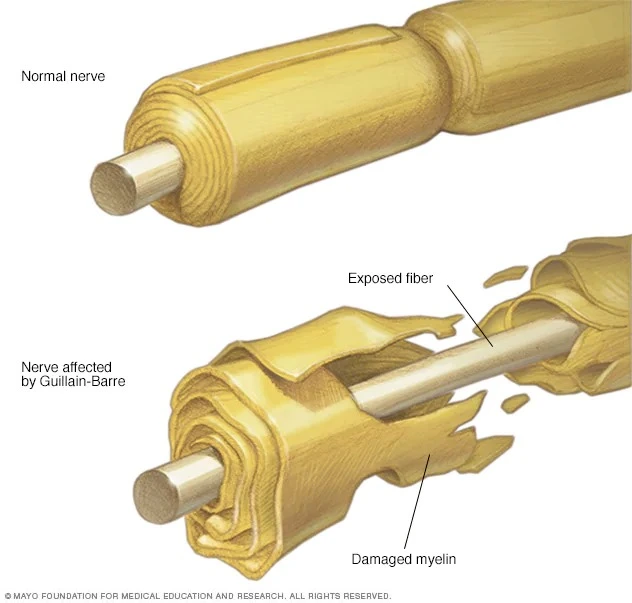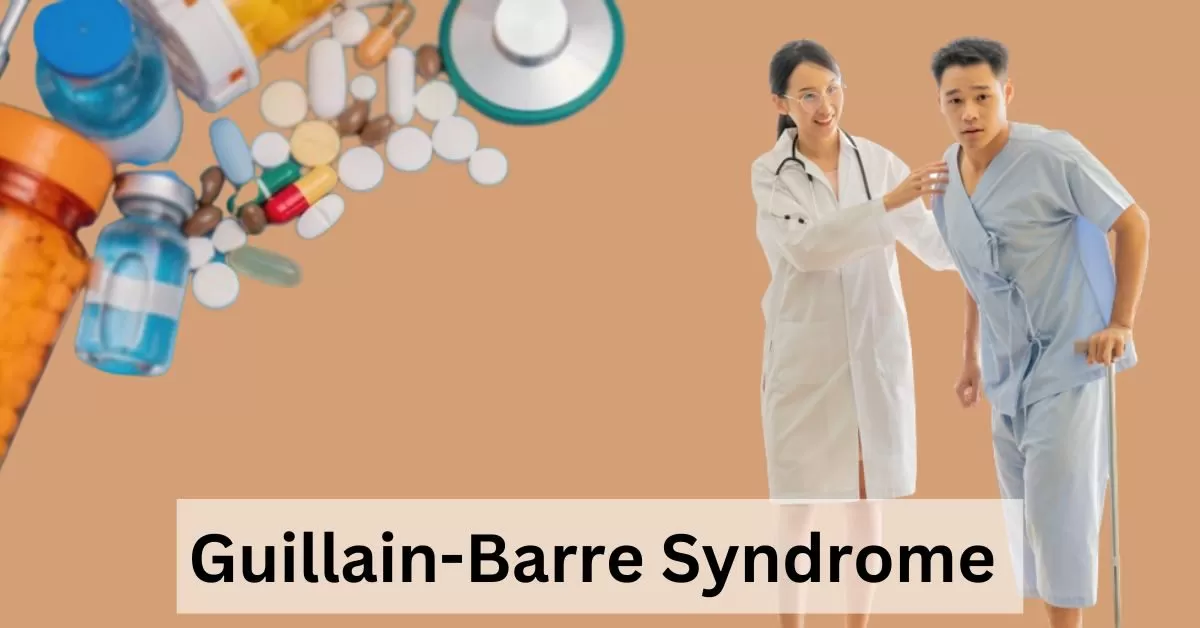Understanding Guillain-Barré Syndrome: Causes, Symptoms, and Treatment
What Is Guillain Barre Syndrome?
Guillain-Barré syndrome (GBS) is a rare neurological disorder characterized by the immune system attacking the peripheral nervous system.
It is an autoimmune condition in which the body’s own immune response damages the myelin sheath surrounding nerve fibers or directly attacks the nerves themselves.
The exact cause of Guillain-Barré syndrome is not fully understood, but it is often preceded by an infection, typically a respiratory or gastrointestinal infection, such as a viral or bacterial infection.
The immune system, while fighting off the infection, mistakenly targets the peripheral nerves.
The hallmark symptom of Guillain-Barré syndrome is muscle weakness that starts in the legs and can progress to the arms and upper body.
The weakness usually develops over a period of days to weeks and can vary in severity. Other common symptoms include tingling sensations, numbness, loss of reflexes, and difficulty with coordination and balance.
In some cases, GBS can lead to complete paralysis of the muscles.
The progression and severity of Guillain-Barré syndrome can vary from person to person. In severe cases, the condition can affect the muscles responsible for breathing and require mechanical ventilation.
GBS is a medical emergency, and immediate medical attention is necessary to prevent complications and provide supportive care.
The treatment for Guillain-Barré syndrome aims to manage the symptoms and promote recovery.
This may include intravenous immunoglobulin (IVIG) therapy to suppress the immune response, plasma exchange (plasmapheresis) to remove harmful antibodies from the blood, pain medications, and physical therapy to help regain strength and mobility.
Fortunately, most individuals with Guillain-Barré syndrome experience a gradual recovery and regain their strength over time.
However, the recovery process can be lengthy, ranging from weeks to months or even years. Rehabilitation and supportive care are often needed to help individuals regain full function.

Summry:
- Guillain-Barré syndrome (GBS) is a rare neurological disorder.
- It is an autoimmune condition where the immune system mistakenly attacks the peripheral nervous system.
- GBS is often preceded by a respiratory or gastrointestinal infection.
- The immune system’s response to the infection damages the myelin sheath or nerves themselves.
- The main symptom is muscle weakness that starts in the legs and may progress to other parts of the body.
- Other common symptoms include tingling, numbness, loss of reflexes, and coordination difficulties.
- Severe cases can lead to complete paralysis and require mechanical ventilation.
- Prompt medical attention is crucial for managing GBS and preventing complications.
- Treatment options include intravenous immunoglobulin (IVIG) therapy, plasma exchange (plasmapheresis),
- pain medications, and physical therapy.
- Recovery from GBS is often gradual and can take weeks, months, or even years.
- Rehabilitation and supportive care are important for regaining full function.
- Consulting with a healthcare professional is necessary for an accurate diagnosis and appropriate management.
What is the Main Cause of Guillain-Barre Syndrome?
The exact cause of Guillain-Barré syndrome (GBS) is not fully understood, but it is believed to be an autoimmune disorder.
The condition typically occurs after a respiratory or gastrointestinal infection, most commonly caused by viral or bacterial infections.
The immune system, while fighting off the infection, mistakenly attacks the peripheral nerves or the myelin sheath surrounding them.
Some of the infections that have been associated with GBS include:
Campylobacter jejuni infection: This bacterium is commonly found in contaminated food, particularly undercooked poultry.
Respiratory infections: Certain viruses, such as the influenza virus, Epstein-Barr virus, and cytomegalovirus, have been linked to GBS.
Gastrointestinal infections: Infections caused by bacteria like Salmonella and Shigella have been associated with GBS.
Zika virus infection: Although rare, GBS can be triggered by Zika virus infection, which is primarily transmitted through mosquito bites.
The exact mechanisms by which these infections trigger GBS are still under investigation, and research continues to explore the complex relationship between infections and autoimmune responses in GBS.
What are the basic Symptoms of Guillain-Barre Syndrome?
The symptoms of Guillain-Barré syndrome (GBS) can vary from person to person, but they typically involve weakness and abnormalities in the peripheral nervous system. Here are the main symptoms associated with GBS:
Muscle weakness: GBS often starts with weakness in the legs that can progress to the arms and upper body.
The weakness tends to be symmetrical, affecting both sides of the body equally. The weakness may begin in the lower body and gradually ascend to the upper body.
Tingling and numbness: Many individuals with GBS experience sensations of tingling, numbness, or a “pins and needles” feeling in their extremities, such as the hands, feet, fingers, or toes.
This sensation may spread or migrate from one area to another.
Loss of reflexes: GBS can cause a loss of reflexes, such as the knee jerk reflex or the ability to rapidly move the ankle upward when the sole of the foot is stimulated (known as the plantar reflex).
Coordination difficulties: GBS may lead to problems with coordination and balance.
Tasks that require fine motor skills, such as writing or buttoning a shirt, can become challenging.
Pain: Some individuals with GBS experience significant pain, which can vary in intensity.
The pain is often described as aching, cramping, or shooting sensations in the affected muscles or nerves.
Autonomic dysfunction: In more severe cases, GBS can affect the autonomic nervous system, which controls involuntary bodily functions.
This can lead to symptoms like fluctuations in blood pressure or heart rate, abnormal sweating, and difficulties with bowel and bladder control.
Treatment of Guillain-Barre Syndrome?
The treatment of Guillain-Barré syndrome (GBS) focuses on managing the symptoms, providing supportive care, and promoting recovery. Here are the main approaches used in the treatment of GBS:
Intravenous Immunoglobulin (IVIG) Therapy: This treatment involves administering high doses of immunoglobulins, which are antibodies obtained from healthy donors.
IVIG therapy helps to suppress the abnormal immune response and reduce inflammation, potentially speeding up recovery. It is typically given over a course of several days.
Plasma Exchange (Plasmapheresis): Plasmapheresis involves removing the liquid part of the blood (plasma) that contains harmful antibodies and replacing it with healthy donor plasma or a plasma substitute.
This procedure helps to remove the antibodies that are attacking the nerves and may help improve symptoms.
Medications for Pain and Discomfort: Pain medications, such as nonsteroidal anti-inflammatory drugs (NSAIDs) or opioids, may be prescribed to manage the pain associated with GBS.
Other medications can be given to address specific symptoms, such as anticoagulants to prevent blood clots or medications to regulate heart rate and blood pressure.
Physical Therapy: Physical therapy plays a crucial role in GBS treatment. It involves exercises and rehabilitation techniques to help maintain muscle strength, prevent muscle stiffness and joint contractures, and promote mobility and independence. Physical therapists can provide guidance on appropriate exercises and assistive devices.
Respiratory Support: In severe cases of GBS, when the muscles responsible for breathing are affected, mechanical ventilation may be necessary.
Different methods of respiratory support can be employed, ranging from non-invasive techniques such as a mask or nasal device to invasive methods like a tracheostomy.
Supportive Care: GBS can be physically and emotionally challenging, so supportive care is essential.
This may involve providing assistance with daily activities, monitoring vital signs, managing complications such as bedsores or infections, and addressing any psychological or emotional needs.
The specific treatment plan for an individual with GBS will depend on the severity of the condition and other factors. Early intervention and close medical monitoring are crucial for managing GBS effectively.
It’s important to work closely with healthcare professionals to determine the most appropriate treatment approach for each individual case.
Recommendations treatment by WHO
As of my knowledge cutoff in September 2021, the World Health Organization (WHO) does not have specific treatment guidelines for Guillain-Barré syndrome (GBS).
However, they provide general recommendations for the management of GBS based on available evidence and expert consensus.
It’s important to note that treatment approaches may evolve over time, and it’s advisable to consult the most recent guidelines or recommendations from the WHO or other trusted medical sources.
Here are some general recommendations for GBS management:
Early Diagnosis and Referral: GBS is a medical emergency, and early diagnosis is crucial. Healthcare providers should be trained to recognize the symptoms and promptly refer suspected cases to specialized centers for appropriate care.
Supportive Care: GBS patients require comprehensive supportive care, which includes monitoring vital signs, respiratory function, and preventing complications such as deep vein thrombosis, pressure ulcers, and infections.
Close observation and management of autonomic dysfunction are also important.
Intravenous Immunoglobulin (IVIG): IVIG therapy is recommended as the first-line treatment for GBS.
The standard dosage is 0.4 g/kg body weight per day for 5 consecutive days. However, dosing and treatment duration may vary based on individual patient factors and clinical judgment.
Plasma Exchange (Plasmapheresis): Plasmapheresis is an alternative treatment option to IVIG, particularly when IVIG is contraindicated or not available.
It involves the removal of the patient’s plasma and its replacement with an equal volume of a substitute fluid.
Rehabilitation and Physical Therapy: Early rehabilitation and physical therapy are essential for maximizing functional recovery.
This includes mobilization, range-of-motion exercises, muscle strengthening, and assistance with activities of daily living. The involvement of a multidisciplinary rehabilitation team is recommended.
Psychosocial Support: GBS can have a significant impact on the psychological well-being of patients. Psychosocial support, including counseling and mental health services, should be provided to address emotional, social, and psychological needs.
Prognosis and Recovery: While Guillain-Barré syndrome can be a severe and debilitating condition, the majority of individuals with GBS experience a gradual recovery over time.
However, the recovery process can be lengthy, ranging from weeks to months or even years. Some individuals may experience residual weakness or other long-term complications.
Follow-up Care: After the acute phase of GBS, ongoing follow-up care is important to monitor progress, address any residual symptoms, and provide additional rehabilitation support as needed.
Regular medical check-ups, including neurological assessments, can help ensure optimal recovery and address any potential complications.
Variants of GBS: There are different variants or subtypes of Guillain-Barré syndrome, including acute inflammatory demyelinating polyradiculoneuropathy (AIDP), Miller Fisher syndrome (MFS), and others.
These variants may have specific clinical features and require tailored management approaches.
Research and Advances: Ongoing research is being conducted to better understand the underlying mechanisms of GBS, improve diagnostic methods, and develop more effective treatments.
Scientific advancements in areas such as immunology, neurology, and genetics contribute to a deeper understanding of GBS and may lead to innovative therapies in the future.
Support Organizations: There are various support organizations and patient advocacy groups dedicated to Guillain-Barré syndrome.
These organizations provide valuable resources, information, and support networks for individuals with GBS and their families. Examples include the GBS/CIDP Foundation International and local GBS support groups.
Prevention: Since GBS is often associated with preceding infections, taking preventive measures to reduce the risk of infections can potentially lower the chances of developing GBS.
Practicing good hygiene, following proper food safety measures, and getting vaccinated against certain infections can help reduce the risk of infection-related GBS.
Jagranjosh Highly Recomended blog for Guillain-Barre syndrome (GBS)

Ankit Sharma
Ankit Sharma is an Ex. Software Engineer and Contributing Writer to B For Blogs. He has worked in leading Multi National Companies and has a vast experience in Corporate Sector. He is also a member of the Legal Fraternity in India.







